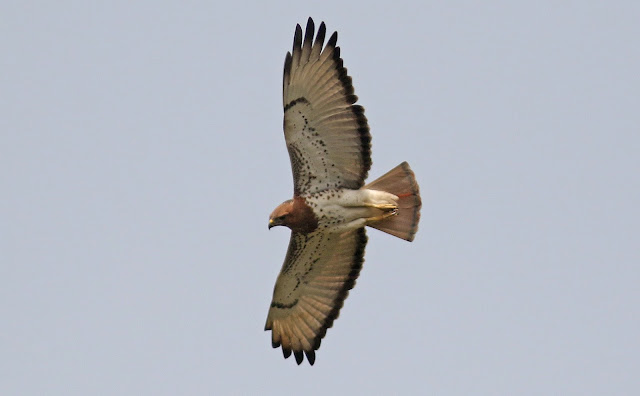Had an interesting gull at the farmlands in the week coinciding with the blast of northerly air. It stood out as a lot of the upperparts were still juvenile, there was a uniform wash over the underparts and mantle and there were clear white tips to the primaries. On the spread wing the primary window extended to the outer primaries, there was a prominent secondary bar and the underwing was overall very pale with dark confined to the tips of the outer primaries. The undertail coverts were barred and the uppertail coverts were heavily barred.
A smoky wash over the underparts and mantle contrasting with a paler head
The pale inner webs extending to the outer primaries and heavily barred uppertail coverts are shown here
The pale underwing with dark confined to tips to of the primaries is visible on this shot. The underwing coverts are also smoky.
Another shot of the heavily barred uppertail coverts and smoky wash to the mantle
The pale primary tips are just visible in this shot
These smoky northern gulls with extensive pale in the primaries pop up from time to time at Beddington (and widely elsewhere) and there are various possibilities of what they can be:
1) Pale argentatus Herring Gull- generally paler birds are considered to be high latitude birds of the northern nominate form of Herring Gull,
2) Hybrid Glaucous x Herring Gull (Viking Gull)
3) Variable birds from the Faroes and Iceland (where there is historical introgression of argenteus (argentues being the race present on the North Atlantic islands) with perhaps American Herring Gull (in Iceland most probably) plus wide spread hybridisation with Glaucous Gull
4) Hybrid Glaucous x American Herring Gull - Nelson's Gull (the short bill and sparsely barred undertail coverts on this bird don't point towards that)
5) They also superficially resemble Thayer's Gull but on this bird among other features the overall tones and structure are not right and the pale inner webs do not extend to the outermost primaries
I asked round for a few opinions and a northern Herring Gull is the favourite (Faroes and Iceland suggested which would mean a northern argenteus) with Viking Gull the next favourite. Here's a bit more on these birds HERE.

















































